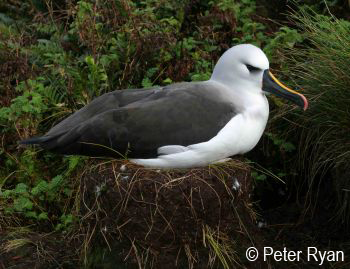John Paterson (Albatross Task Force Namibia, Walvis Bay, Namibia) and colleagues write in the journal Oryxon the large numbers of seabirds estimated killed by longliners in Namibian waters.
“Seabird bycatch is widely regarded as the greatest threat globally to procellariiform seabirds. Although measures to reduce seabird–fishery interactions have been in existence for many years, uptake in fleets with high risk profiles remains variable. We recorded seabird bycatch and other interactions in the Namibian demersal longline fishery. Interaction rates were estimated for seasonal and spatial strata and scaled up to fishing effort data. Bycatch rates were 0.77 (95% CI 0.24–1.39) and 0.37 (95% CI 0.11–0.72) birds per 1,000 hooks in winter and summer, respectively. Scaling up to 2010, the most recent year for which complete data are available, suggests 20,567 (95% CI 6,328–37,935) birds were killed in this fishery that year. We compared bycatch rates to those from experimental fishing sets using mitigation measures (one or two bird-scaring lines and the replacement of standard concrete weights with 5 kg steel weights). All mitigation measures significantly reduced the bycatch rate. This study confirms the Namibian longline fishery has some of the highest known impacts on seabirds globally, but implementing simple measures could rapidly reduce those impacts. In November 2015 the Ministry of Fisheries and Marine Resources introduced regulations requiring the use of bird-scaring lines, line weighting and night setting in this fishery. A collaborative approach between NGOs, industry and government was important in achieving wide understanding and acceptance of the proposed mitigation measures in the lead up to the introduction of new fishery regulations.”

Atlantic Yellow-nosed Albatross: at risk to longlines off Namibia, photograph by Peter Ryan
Reference:
Paterson, J.R.B., Yates, O., Holtzhausen, H., Reid, T., Shimooshili, K., Yates, S., Sullivan, B.J., & Wanless , R.M. 2017. Seabird mortality in the Namibian demersal longline fishery and recommendations for best practice mitigation measures. Oryx doi.org/10.1017/S0030605317000230.
John Cooper, ACAP Information Officer, 21 June 2017

 English
English  Français
Français  Español
Español